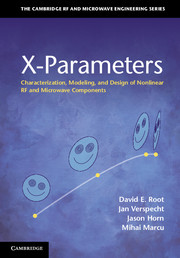Book contents
- Frontmatter
- Contents
- Preface
- Acknowledgments
- 1 S-parameters – a concise review
- 2 X-parameters – fundamental concepts
- 3 Spectral linearization approximation
- 4 X-parameter measurement
- 5 Multi-tone and multi-port cases
- 6 Memory
- Appendix A Notations and general definitions
- Appendix B X-parameters and Volterra theory
- Appendix C Parallel Hammerstein symmetry
- Appendix D Wide-band memory approximation
- Appendix E Solutions to exercises
- Index
- References
4 - X-parameter measurement
Published online by Cambridge University Press: 05 October 2013
- Frontmatter
- Contents
- Preface
- Acknowledgments
- 1 S-parameters – a concise review
- 2 X-parameters – fundamental concepts
- 3 Spectral linearization approximation
- 4 X-parameter measurement
- 5 Multi-tone and multi-port cases
- 6 Memory
- Appendix A Notations and general definitions
- Appendix B X-parameters and Volterra theory
- Appendix C Parallel Hammerstein symmetry
- Appendix D Wide-band memory approximation
- Appendix E Solutions to exercises
- Index
- References
Summary
One of the key features that led to the wide adoption of S-parameters was the availability of hardware and calibration techniques capable of making quick, accurate, and repeatable S-parameter measurements. S-parameters can also be easily extracted in simulation from device or circuit models. In either case, the resulting S-parameters can immediately be used in simulation or design tools. In order to achieve similar success in the nonlinear domain, X-parameters must be easily measured and also easily extracted from simulation.
Measurement hardware
X-parameters, like S-parameters, represent the steady-state behavior of a device in the frequency domain. The linearity assumption of S-parameters, however, greatly simplifies the measurement requirements. The additional capabilities of X-parameters come at the cost of additional complexity in the measurement system as well as the modeling paradigm.
Hardware requirements
X-parameters include cross-frequency terms that capture the distortion products generated by device nonlinearities. In order to measure these terms, the measurement hardware must be capable of measuring coherent cross-frequency phase. Because S-parameters include no cross-frequency interaction (a consequence of the linearity assumption), each frequency may be measured independently with no need for a consistent time base or cross-frequency phase. Since all S-parameters are ratios of waves, there is also no need for accurate measurement of absolute power – only the relative power is needed. As a result, the hardware and calibration techniques developed for S-parameter measurement generally are not sufficient for X-parameter measurement and must be extended to include cross-frequency phase and calibrated absolute power.
- Type
- Chapter
- Information
- X-ParametersCharacterization, Modeling, and Design of Nonlinear RF and Microwave Components, pp. 88 - 111Publisher: Cambridge University PressPrint publication year: 2013

